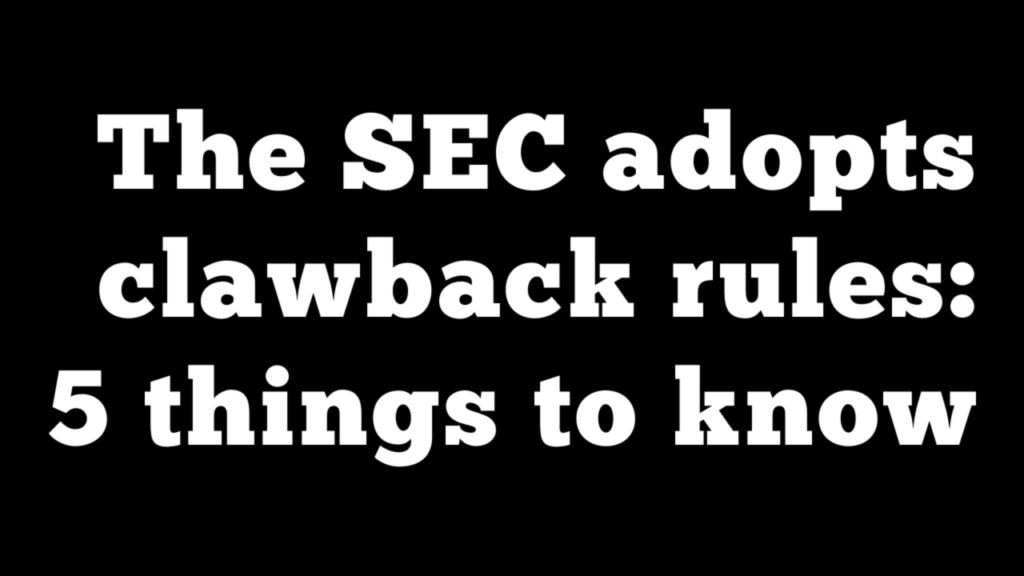The SEC adopts clawback rules: 5 things to know

Here’s something that Perkins Coie’s Sue Morgan and Kelly Reinholdtsen blogged yesterday on PublicChatter.com:
Yesterday, the SEC adopted the clawback rules that have had quite a long journey, as noted in our blog a few days ago. Here’s the press release, fact sheet and 230-page adopting release.
Here are five things to know:
- All Listed Companies Will Be Required to Adopt a Clawback Policy: The SEC adopted Exchange Act Rule 10D-1, which requires the stock exchanges to adopt listing standards that will require listed companies to adopt a compliant clawback policy and make specified proxy statement disclosures about application of the policy. Failure to comply with the listing standards can result in delisting.
- The Ball is Now in the NYSE and Nasdaq’s Court to Adopt Listing Standards: Although the SEC’s final rules become effective 60 days after they are published in the Federal Register, the real action requires the stock exchanges to adopt listing standards that implement the new rules.
The stock exchanges have 90 days from when the SEC’s rules are published in the Federal Register to propose new listing standards – and one year from the Federal Register publishing date to adopt listing standards. That means the stock exchanges have to act relatively fast. Listed companies will then have 60 days from when the listing standards become effective to adopt a clawback policy.
- Clawback Rules Covers “Little R” Restatements: If a listed company has a restatement, the company must act to recover incentive-based compensation that was erroneously awarded during the three years preceding the date such a restatement was required from any current – and former – executive officers. Executive officers include all Section 16 officers.
The scope of the final rules was expanded to include so-called “little r” restatements made to correct an error that would result in a material misstatement if the error were corrected in the current period or left uncorrected in the current period.
The recoverable amount is the amount of incentive-based compensation received in excess of the amount that otherwise would have been received had it been determined based on the restated financial measure.
4. Three Limited “Impracticability” Exceptions for Clawbacks: The listing standards will require companies to pursue recovery of erroneously awarded compensation, subject to limited impracticability exceptions where:
– Direct expenses paid to third parties to assist in enforcing the policy would exceed the amount to be recovered and the company has made a reasonable attempt to recover;
– Recovery would violate home country law that existed at the time of adoption of the rule, and the company provides an opinion of counsel to that effect to the exchange; or
– Recovery would likely cause an otherwise tax-qualified retirement plan to fail to meet the requirements of the Internal Revenue Code.- Proxy Statement Disclosures/10-K Exhibit & Cover Check Boxes: The clawback policy will be filed as an exhibit to the Form 10-K. The Form 10-K cover will also have two new check boxes once the stock exchanges act. One check box to indicate whether the financial statements reflect a correction of an error to previously issued financial statements. And the other check box to indicate whether any error correction involved a restatement that required a compensation recovery analysis.
A new Item 402(w) of Regulation S-K will require listed companies to disclose in their proxy statements how they have applied the policy, including, as relevant:
– The date it was required to prepare a restatement and the aggregate dollar amount of erroneously awarded compensation attributable to the restatement (including the estimates used for awards based on stock price or total shareholder return);
– The aggregate outstanding amount and any outstanding amounts due from any current or former named executive officer for 180 days or more, each as of the end of the last fiscal year; and;
– The details regarding any reliance on the impracticability exceptions.
Companies will be required to use Inline XBRL to tag their disclosure.
